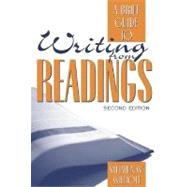
All chapters include “Definition and Purpose.”
Preface.
Acknowledgments.
1. Critical Reading.
Asking Questions about What You Read.
Questions to Ask Before You Begin a Close Reading of the Text. Questions to Ask While You Read and Reread Material.
Marking Texts.
Highlighting Texts. Annotating Texts.
Sample Annotated Text: Patrick Moore, Hard Choices.
Note Taking.
Additional Reading: Henry Weclasler, Getting Serious about Eradicating Binge Drinking.
Summary Chart — Critical Reading: Asking Questions.
Summary Chart — Critical Reading: Marking Texts.
Summary Chart — Critical Reading: Note Taking.
2. Journals.
Types of Entries.
Summaries. Analyses. Responses. Reflections. Questions. Critiques. Syntheses. Applications. Refutations. Outlines. Drafts. Personal Experience. Self-Reflections. Creative Writing. Drawings.
Language and Format.
Language. Format.
Final Considerations.
3. Quotation.
Guidelines on When to Quote Material.
Quote Passages When Author Has Written Something in a Distinctive or Especially Insightful or Interesting Way. Quote Material That Lends Support to a Position You Are Trying to Make in Your Paper. Quote Authorities Who Disagree with a Position You Are Advocating or Who Offer Alternative Explanations or Contradictory Data.
Guidelines on When Not to Quote Material.
Do Not Quote Passages Just to Fill Space. Do Not Quote Passages as a Substitute for Thinking. Do Not Quote Passages Because You Do Not Understand the Author's Ideas Well Enough to Paraphrase Them.
Integrating Quotations into Your Writing.
Two Basic Types of Quotations.
Reading: “Missing Link.”
The Block Quotation. The Integrated Quotation.
Altering Quoted Material and Avoiding Misquotations.
Summary Chart: Guidelines on Quotations.
Summary Chart: Integrating Quotations into Your Writing.
4. Paraphrase.
Qualities of a Good Paraphrase.
Thorough. Accurate. Fair. Objective.
How to Paraphrase Material.
Changing Words. Changing Sentence Structure. Combining Sentences. “Unpacking” Sentences.
Documentation.
Summary Chart: How to Write a Paraphrase.
Summary Chart: Qualities of a Good Paraphrase.
5. Summary.
Types of Summaries.
Qualities of a Good Summary.
Comprehensive. Brief. Accurate. Neutral. Independent.
How to Summarize a Text.
Read, Reread, and Annotate the Source Text. Summarize Each Section of the Source Text. Write Your First Draft. Check the Draft against the Source Text. Rewrite the Summary.
Documentation.
Sample Summaries.
Reading: Gerard Piel, AIDS and Population “Control.”
Sample Informative Summary.
Sample Exploratory Summary.
Summary Chart: How to Write a Summary.
6. Response Essays.
Qualities of a Good Response Essay.
Honest. Informed. Clear. Well Supported.
Writing the Response Essay.
Carefully Read the Material. Explore Your Responses to the Reading as You Annotate the Text. Compose Your Rough Draft. Revise Your Rough Draft.
Sample Response Essay.
Summary Chart: How to Write a Response Essay.
7. Critique.
The Film Review as Critique.
Writing a Critique.
Step 1: Carefully Read and Annotate the Source Text. Step 2: Analyze and Evaluate the Reading. Step 3: Write Your Thesis and Decide Which Aspects of the Reading You Will Focus on in Your Essay. Step 4: Write Your Rough Draft. Step 5: Rewrite Your Critique.
Reading: Joan Beck, Clear Message to Teens: “It's OK to Have Sex.”
Sample Critique: Beck's Essay Not Convincing.
Additional Reading: Margaret Pruitt Clark, Condom Availability Promotes Health, Saves Lives.
Additional Reading: Edwin J. Delattre, Apply Peer Pressure, Not Latex, against Casual Sex.
Summary Chart: Writing a Critique.
8. Synthesis.
Types of Synthesis Essays.
Reading: Brian D. Johnson, The Fool on the Hill.
Reading: David Ansen, Forrest Gump.
Reading: Peter Travers, Forrest Gump.
Informative Synthesis.
Definition. Writing an Informative Synthesis.
Argumentative Synthesis.
Definition. Writing an Argumentative Synthesis.
Sample Informative and Argumentative Synthesis.
Sample Informative Synthesis. Sample Argumentative Synthesis (Focusing on the Quality of the Readings). Sample Argumentative Synthesis (Focusing on the Topic of Readings).
Additional Reading: Laurie Mifflin, N.A.A.C.P. Plans to Press for More Diverse TV Shows.
Additional Reading: Earl Ofari Huchinson, Race and TV: Here's What's Wrong with This Picture.
Additional Reading: Damson Standifer, Race and TV: Protesting Too Much, We Hurt Ourselves.
Summary Chart: Synthesis Essays.
9. Plagiarism.
Forms of Plagiarism.
Purchasing a Paper. Turning in a Paper Someone Else Has Written for You. Turning in Another Student's Work without That Student's Knowledge. Improper Collaboration. Copying a Paper from a Source Text, Supplying Proper Documentation, but Leaving out Quotation Marks. Paraphrasing Material from a Reading without Proper Documentation.
How to Avoid Plagiarism.
Do Your Own Work. Take Good Notes. Paraphrase Properly. Supply Proper Documentation. Clarify Collaboration Guidelines.
Summary Chart: Plagiarism.
10. Documentation.
Types of Documentation.
Primary Academic Style Manuals.
APA Guidelines.
In-Text Documentation. Footnotes and Endnotes.
CBE Guidelines.
In-Text Documentation. Footnotes and Endnotes.
MLA Guidelines.
In-Text Documentation. Footnotes and Endnotes.
11. Reference Lists and Works Cited Entries.
APA Format.
Sample Reference List Entries. Reference Page. Sample Reference Page: APA Format.
CBE Format.
Sample Reference List Entries. Reference List Guidelines. Sample Reference List: Citation-Sequence Format. Sample Reference List: Name-Year Format.
MLA Format.
Sample Works Cited Entries. Works Cited List. Sample Works Cited List: MLA Format.
12. Timed Writing Assignments.
A Range of Timed Writing Assignments, Purposes, and Conditions.
Common Timed Writing Tasks. Rhetorical Aims. Access to Source Material. Access to Possible Assignments.
Qualities of a Good Timed Essay.
Appropriate. Concise. Supported. Organized. Clear and Correct.
Writing Timed Assignments.
Prepare Yourself Outside of Class. Read and Analyze the Assignment or Test Question. Plan Your Essay or Answer. Draft Your Essay or Answer. Revise Your Essay or Answer. Proofread Your Essay or Answer.
Final Thoughts.
Summary Chart: How to Write Timed Essays.
Appendix : Revision Checklists.
Quotation Checklist.
Paraphrase Checklist.
Summary Checklist.
Response Essay Checklist.
Critique Checklist.
Synthesis Checklist.
Plagiarism Checklist.
The New copy of this book will include any supplemental materials advertised. Please check the title of the book to determine if it should include any access cards, study guides, lab manuals, CDs, etc.
The Used, Rental and eBook copies of this book are not guaranteed to include any supplemental materials. Typically, only the book itself is included. This is true even if the title states it includes any access cards, study guides, lab manuals, CDs, etc.